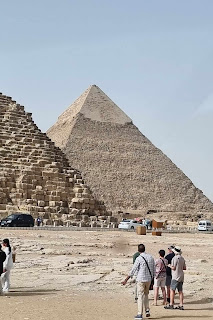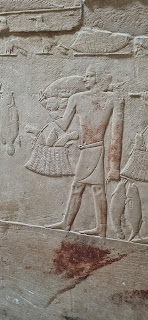Pyramids and more
The first day of our tour took us to the Giza Plateau to view the Great Pyramid and it's next door neighbour the Pyramid of Khafre. As we arrived our guide warned us that cameras with 'lenses' were not allowed and would be held at security. Trace was not impressed and it was unclear if he meant SLR cameras with detachable lenses or any 'second' lens you may have. In the end it didn't matter because some rules seem to be there just for the sake of it. We got off the bus, leaving our bags behind and went through security, including a metal detector. After clearing security we got back on the bus, which had driven forward through it's own gate and were reunited with our bags and cameras. Who knows what the point of all that was. Speaking of security, we had a member of the Tourist Police on board all day, ostensibly to help speed our passage through different checkpoints, but he was carrying what looked like a sub-machine gun.
At our first stop we had 45 minutes to look around the pyramids. Given we rarely do tours we found this wasn't quite enough, but made the most of it regardless. The numbers are quite staggering with the Great Pyramd being comprised of around 2.5 Million blocks weighing up to 70 tonnes. Our Guide was saying that no-one has yet come up with a feasible suggestion for how they got them there. As well as the pyramids there are three vey large holes in the ground where archeologists recently found boats. The boats were to assist the King and his family to travel from here to heaven. No-one on our group chose to enter either of the tombs here as neither have anything inside.
From the pyramids we went to a panaramic lookout, where we could see several different pyramids. They have found around 110 pyramids, though many are in a very poor state.
Next stop was The Sphinx. Another amazing piece of construction. The Sphinx is made from a single block of limestone having been cut directly from the bedrock. The size is mind boggling, being 76 metres long and 20 metres high.
After lunch we visited Saqqara the home of the oldest pyramid still standing, but before seeing that we went to a few nearby temples and down into a tomb. This tomb had hieroglyphics on the walls, stars on the ceiling and the remains of a tomb. The entrance was both small - about 4 foot 6 high (140 cm) - and thankfully short, only about 25 metres long. We visited several of the nearby temples, seeing many engravings depicting anything from hunting to perfume making, circumcision and childbirth. Many of the figures were colored to display the brown skin of the men. The women were not colored as they spent their time indoors and didn't get a tan.
The Step Pyramid of Saqqara was our final stop for the day and was no less impressive than the earlier pyramids. The fact that it is the oldest and yet shows no sign of sinking or subsidence is truly amazing.
Today was around 38 degrees and we were all very glad to get back in the bus and head home, though the day had been an incredible experience.
Tuesday 28th May
We had a later start today with the bus leaving at 10:00am to take us to the Egyptian Museum. This was the same museum as the one we visited on our first day, but were happy to return. We followed our guide for the first hour and a half as he pointed out certain items and provided explanations and stories. Some we had not noticed on our first visit - such as a copy of the original Rosetta Stone from the 1800's - and others we had looked at but didn't know the detail. We were given about 45 minutes of free time at the end and re-visited Tutankhamun's mask to marvel at it and his sarcophogii again, and a couple of our favourite Mummies.
From here we went to the National Egyptian Museum of Civilization, which is a very modern building and - thankfully - air-conditioned. The main reason for visiting this museum is the Hall of Royal Mummies. The hall contains 22 Mummies of various Kings and Queens, including 7 Ramses. No photos were allowed so you will have to believe me when I say some were slightly scary but all were fascinating. One thing many of us noted was the elongated skull of many of them. It is believed that constantly wearing the crown and other head fixtures actually causes this distortion.
Lunch was next and as it was now about 4:30 we were all very ready. We then had almost 2 hours relaxing at the hotel, before hopping on an overnight train to Luxor.
Our Guide mentioned several times that this 'was the best train in Egypt, but not the best train in the world'. He certainly didn't want to raise our expectations and probably for good reason. The train was qqqqqqq air-conditioned (barely) but the cabin was very small, with bunk beds, a basin to wash hands/face and not much else. Dinner and breakfast were included though the food was almost inedible, especially breakfast. As for sleep, forget it. Between other trains roaring past and ours speeding up or slowing down, we would have been lucky to get an hours sleep. The bad news is we do it all again, in the reverse order in about a week.

















Comments
Post a Comment